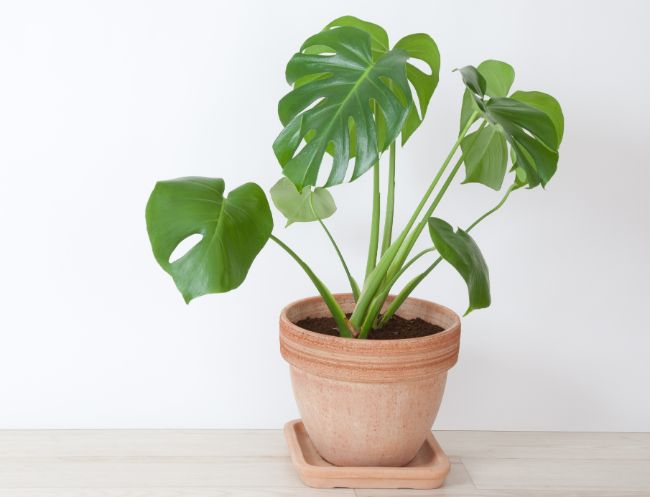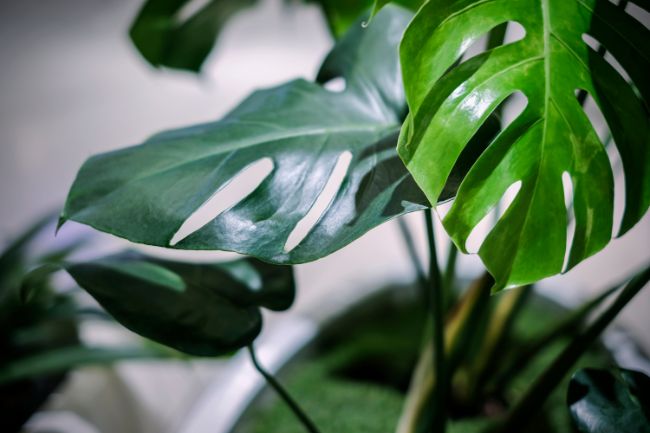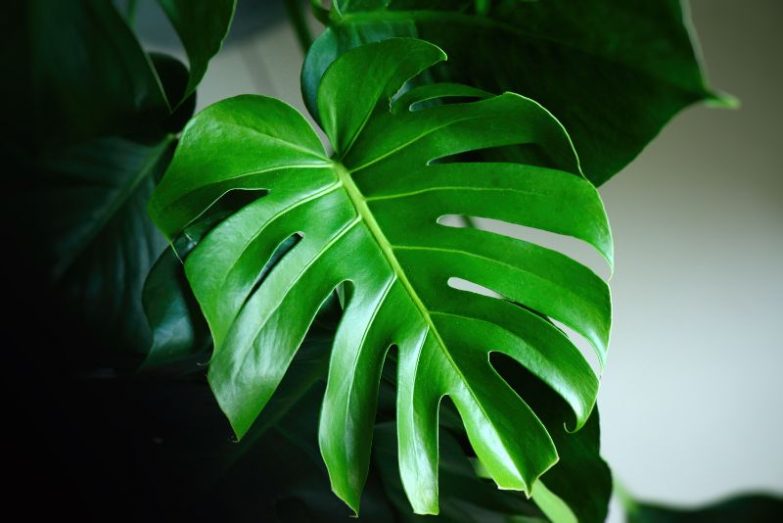The Monstera deliciosa (Swiss Cheese Plant) is a widely grown houseplant, due mainly to the fact that it has such impressive leaves. These guys are easy to maintain but they do come with one disadvantage – if they feel they are being neglected they tend to sulk and you may find your Monstera leaves drooping. Don’t be too alarmed. With a little tender care, they can soon be persuaded to bounce back.
Monstera leaves drooping is most commonly due to lack of water. They like their soil to always be slightly damp. Other causes include overwatering, low light, fertilizer problems, pests, or transplant stress. Identifying the problem is the most important step to nursing your plant back to health.
Why Are My Monstera Leaves Drooping?
If you see the leaves of your Monstera wilting or the whole plant drooping, take some time to examine your plant closely and review the care requirements to help you fix the problem. The good news is that this plant is extremely robust and yours will soon regain its vigor if you give it the right treatment. Let’s look at each possible cause of drooping Monstera leaves in turn.
Underwatering
You will often find sad looking versions of these plants in office blocks and lobbies where the leaves will almost always be covered in dust and drooping forlornly. Despite this neglect, they somehow always seem to cling to life. With only minimal care and attention, these stalwarts will bounce back and reward the caring gardener with striking shiny foliage.
For those new to keeping houseplants, getting the watering right can be one of the most difficult problems to overcome. Some plants need plenty of water and some need hardly any – and what constitutes the correct amount of water anyway?
Knowing where your plant originates from can tell you a great deal about what conditions it needs and these plants come from the south of Mexico and Central America where they thrive in damp tropical forests. Dry soil is certainly not a suitable environment for them.
Correcting Dry Soil
It is possible to purchase meters for testing the moisture level of your soil but they vary in accuracy and aren’t really necessary. You are far better off just pushing your finger into the soil and feeling for dampness. The top two inches should be dry but after that, the soil should remain cool and moist.
If it is not, then its time to give your plant a thorough watering. You can water from the top or bottom, but make sure to soak all the soil when you water your plant.
To water from the bottom, half fill a basin with water and stand your plant in it for 10-20 minutes. Gradually, the soil will absorb water through the process of capillary action.
If watering from the top, the dehydrated potting medium will sometimes let most of the water run straight through without being absorbed by the soil. Counter this by adding a little water at a time, giving the soil plenty of time to absorb the water.
Once you are happy that your soil is sufficiently moist, leave the pot to drain any excess water from the drainage holes, wipe down the plants leaves with a damp sponge to remove any dust, and place it back where it was.
Lighting Problems
These plants are fairly tolerant but remember they are forest plants so ideally, they should get plenty of light but very little direct sunlight. If you see dry brown spots occurring on the leaves you know your plant is getting too much direct sun so move it to a more appropriate position.
Low light will cause your plant to become stretched, with sparse foliage, and more prone to drooping and languishing. Bright light or dappled shade are both ideal. The light will play a critical factor both in the health of your plant and the size that it attains.

Overwatering
Although not as common as under-watering, it is possible to overwater your Monstera plant. It will quickly tell you that it is unhappy by developing weak-looking yellow leaves, often starting with the lower leaves first or showing brown dried-out patches at the leaf tips. You may also detect a rotting smell from the soil, and this can signal the presence of root rot, which is very bad news indeed.
Perform that finger test on the soil again and if it is soggy then you have been overwatering. Check that there is plenty of drainage and that the container has holes in the bottom, then allow the plant to dry out.
Ideally, you want to water the plant thoroughly and then not water again until the top two inches of soil have dried out. If the plant pot is standing on a saucer make sure that this is not constantly filled with water.
Another common factor when excess moisture is a problem is that the plant has been over potted. It can be tempting to assume that if you place your plant in a large pot with more potting soil, then it will have more space to expand into.
What instead tends to happen is that the extra soil absorbs more water and the pot then becomes waterlogged. In effect, the soil surrounding the roots acts like a wet sponge. When potting on a plant always plant it into the next pot size up.
Temperature Stress
Whilst Monstera plants are fairly forgiving in this regard, remember that these plants are tropical so they don’t like to get too cold. An ideal temperature range is between 64 and 84°F (18 to 29°C).
Be alert to any source of cold drafts which can cause your plant considerable stress and lead to your Monstera leaves drooping. If you suspect a temperature issue, you could use a digital thermometer to record the minimum and maximum temperature over a few days and move your plant as needed.
Fertilizer Problems
These plants can get big so they require plenty of nutrients. In the wild, they can easily reach a height of sixty feet, though fortunately when contained in pots they don’t tend to go beyond a more manageable nine feet.
Growth like this requires a regular supply of nutrients so feed them fortnightly with a general-purpose fertilizer during all but the winter months. In the slower-growing cold season, you can drop this to one feed per month.
Take care not to go too crazy with the fertilizer, as applying too much, too often will lead to a build-up in the soil and cause root toxicity. If the roots stop working, and the plant cannot absorb the water and nutrients that it needs, this can result in your Monstera plant drooping.
Look for signs a build-up of fertilizer salts on the surface of the soil and think about what fertilizing schedule you have been doing. If you think you have been a little too generous, flush the soil with water by running water through it for 5-10 minutes. This will help dissolve excess fertilizer salts and wash them out of the soil.
Alternatively, you could repot your Monstera into fresh soil and resume a more conservative fertilizing schedule. Read my guide to fertilizing houseplants for all the info you need to keep your houseplants thriving.

Transplant Stress
As soon as they are happy with their growing conditions, your Monstera deliciosa will gain size quite rapidly. In time you will need to repot the plant into a larger pot. Use one that is just a few inches larger than the one that the plant has been living in.
This overcomes the likelihood of waterlogging but it also ensures that growth doesn’t get too out of hand. You are striving for an eye-catching plant that doesn’t require the use of a machete to get through the front door.
Sometimes houseplants can react badly to repotting, resulting in transplant stress. Monstera leaves drooping after repotting is more likely if the roots were in bad shape, or if they were damaged during the repotting process.
You don’t need to loosen the root ball when repotting of prune the roots unless they are diseased. Make sure to be even more attentive than normal to your Monstera for several weeks after repotting to make sure it settles into its new home.
Lack Of Support
In its natural environment the plant will climb up trees and so you will need to offer it some sort of support to cling to so that growth remains upwards. This will prevent your Monstera drooping and slithering across the room searching for something the climb. Moss poles are ideal for this.
Another reason that your plant might start spreading is that it is searching for more light. Plants that lack light fail to produce those slits in the leaves that is so much a characteristic of the delicious monster.
Deprived of light, the leaves do not develop the slits and remain small and feeble looking. Move the plant to a position with more natural light and the problem will soon be overcome.
Pests
These plants are subject to attack from the usual sap-sucking suspects that affect most indoor foliage plants; namely mealy bugs and red spider mites. Close observation is always the first and most important means of defense.
A bad pest infestation will cause the plant to lose considerable water and nutrients through the injuries on its leaves, resulting in your Monstera leaves drooping, and the whol eplant languishing.
Check the tops and undersides of leaves regularly as it is always easier to deal with plant pests if you attack them before they have had a chance to become established. check out my guide to treating and preventing common houseplant pests.
In Conclusion
If you find your Monstera leaves drooping, the first thing to think about is watering problems. Once you have examined the plant and soil careful to exclude this, take each cause in turn and examine your plant and the surroundings for any signs of a problem.
If you’d like to become a houseplant expert, and learn the skills you need to keep your houseplants thriving and free from problems, check out my book, Houseplants Made Easy. I cover everything you need to know to care for all your houseplants, as well as prevent and fix all of the common problems.

